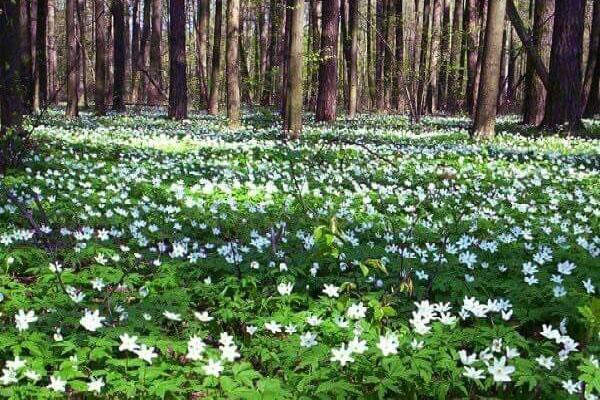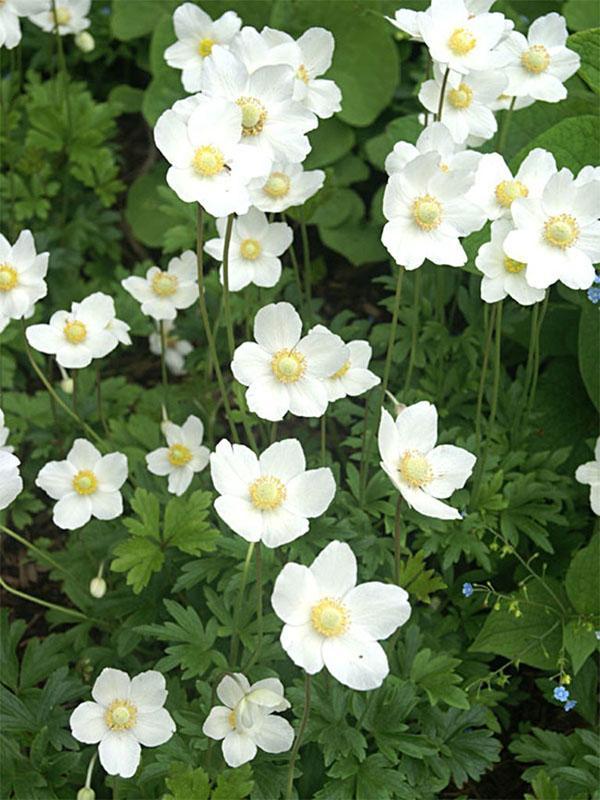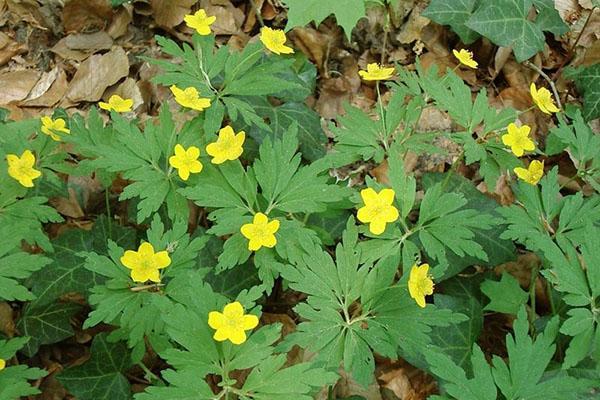Spring garden smile - gentle anemone
 As soon as the first spring rays of the sun hit the ground, snowdrops bloom. And when constant warmth comes, cute flowers appear called - anemone. Looking at these gentle creatures, you notice how gracefully they sway, even with a slight breeze. And the snow-white buds resemble spring snow on green grass.
As soon as the first spring rays of the sun hit the ground, snowdrops bloom. And when constant warmth comes, cute flowers appear called - anemone. Looking at these gentle creatures, you notice how gracefully they sway, even with a slight breeze. And the snow-white buds resemble spring snow on green grass.
The humble flower got its name due to its special sensitivity to the wind. Its large petals react instantly to any changes in the air, while remaining resistant to strong gusts. Translated from Greek, the name of the flower means - "daughter of the winds", which shows its unearthly greatness. In gardening, a huge number of anemone species are grown, and in different shades.
Delicate beauty at the spring festival of flowers

 The anemone belongs to the Buttercup family and is a perennial herb. It grows throughout the Northern Hemisphere, where the climate is relatively moderate. It can be seen on forest edges and vast meadows, on mountain slopes and in river valleys. Wherever an anemone (another name for a flower) appears, it gives spring warmth and a smile to people.
The anemone belongs to the Buttercup family and is a perennial herb. It grows throughout the Northern Hemisphere, where the climate is relatively moderate. It can be seen on forest edges and vast meadows, on mountain slopes and in river valleys. Wherever an anemone (another name for a flower) appears, it gives spring warmth and a smile to people.
This humble plant can grow from 10 to 100 cm in height. The buds come in a variety of colors. Here is some of them:
- snow-white;

- blue;

- blue;

- yellow;

- pink;

- lilac.

Flowers consist of five (sometimes 7 or 8 pieces) delicate petals, which can be semi-double and double. They keep on long single peduncles. Bloom anemones early spring (in colder places in April or May), which attracts the attention of garden plant lovers.
Thanks to the painstaking work of breeders, new varieties of anemone were bred. Some of them bloom in July or September. With a wise approach to growing flowers on the site, you can plant different varieties of anemone. As a result, the flower festival will last a whole season.
The anemone plant has three-times dissected long-petiolate leaves. They are located on short petioles, 3 pieces together. Near the root system, there is sometimes a single leaf or none at all. Interestingly, a smooth cylindrical rhizome is capable of quickly ejecting shoots. Therefore, flowers often form entire colonies, turning the site into a chic carpet.
In June, when the wild flowering leaves, fruits appear on the anemone. They are an oblong sac with a huge number of seeds.  The achenes carried away by the wind often find their way to new territories, where delicate spring flowers may appear.
The achenes carried away by the wind often find their way to new territories, where delicate spring flowers may appear.
Growing anemone in the garden
 The anemone flower usually blooms much earlier than leaves appear on trees and bushes. Therefore, initially it is better to plant them in shady places or in partial shade. After all, their old relatives grew in dense thickets of majestic forests.
The anemone flower usually blooms much earlier than leaves appear on trees and bushes. Therefore, initially it is better to plant them in shady places or in partial shade. After all, their old relatives grew in dense thickets of majestic forests.
Anemones look harmoniously against the background of dwarf barberry or spirea bushes. Their delicate outfit stands out cutely among tulips or pansies.And charming thickets can decorate any country front garden and give a lot of positive emotions.
Planting and leaving an anemone involves following simple rules:
- Suitable soil. Anemones prefer light humus soil, which should be moist. Even after the flower shoots die off, it is necessary to water the area moderately. Some types of anemone require additional substances in the soil - dolomite flour or wood ash.

- Regular care of floral carpets. Since delicate anemones can grow rapidly, forming dense green bedspreads, it is necessary to maintain their decorative effect. For this, the plant is transplanted to new sites. It is better to start the transplanting process before the plant loses its foliage and prepares for winter. In some cases, flowering anemones can also be transplanted.

- Proper watering of the plant. Due to the fact that the anemone blooms in early spring, it becomes clear that it loves moisture. If the spring is dry, it is important to constantly moisten the soil under the anemone flower carpet. Summer and fall varieties should also not be left without additional moisture.

- Reproduction. To breed an anemone with rhizomes, it is not necessary to completely dig it out of the soil. It is enough to remove small elements with kidneys from it in order to place them in a new place. Flowers can also be propagated through sowing seeds.

When planting pieces of rhizome, do not cover the root collar with soil. It must remain at ground level to germinate successfully.
Cute kinds of modest flowers
 The anemone shown in the photo is a beautiful flower that has been used in gardening for several centuries. It is especially prized during the lush bloom in early spring. In nature, there are more than 150 types of cute "spring smile". In Russia, there are about 46 varieties. A detailed acquaintance with some of them will allow you to get to know this sweet shy girl better.
The anemone shown in the photo is a beautiful flower that has been used in gardening for several centuries. It is especially prized during the lush bloom in early spring. In nature, there are more than 150 types of cute "spring smile". In Russia, there are about 46 varieties. A detailed acquaintance with some of them will allow you to get to know this sweet shy girl better.
Forest anemone
 This pretty flower opens its buds in early spring. It grows in height from 20 to 50 cm. Likes to grow in thickets of low bushes and in forest glades. It is found in the northern expanses of Europe, in Siberia, on the mountain slopes of the Crimean and Caucasian mountains.
This pretty flower opens its buds in early spring. It grows in height from 20 to 50 cm. Likes to grow in thickets of low bushes and in forest glades. It is found in the northern expanses of Europe, in Siberia, on the mountain slopes of the Crimean and Caucasian mountains.
The root system of the forest anemone consists of a powerful vertical black rhizome. At the beginning of spring, basal leaf plates grow from it, about 20 cm in size.In mid-May, peduncles with large white buds appear from the rosette. In rare cases, the back of the inflorescence is colored lilac. The heart of a modest flower is yellow, which looks original against the background of a lush green carpet.
The plant's feathery leaves are usually green. The plate is cut, resembles green carrots, but a little larger. Flowers grow in large colonies, completely covering the soil.
Anemone
 When the warm rays of the spring sun melt the last snow, an anemone grows from the soil. The slender flower reaches only 20 cm in height. The leaf plates are long-petiolate, originally dissected in three places. The buds are most often white, but sometimes purple and light pink specimens are found. The flowering period is April or early May. The fruits appear in the form of an elongated achene, which contains many seeds. The plant likes to grow under wide crowns of trees or bushes.
When the warm rays of the spring sun melt the last snow, an anemone grows from the soil. The slender flower reaches only 20 cm in height. The leaf plates are long-petiolate, originally dissected in three places. The buds are most often white, but sometimes purple and light pink specimens are found. The flowering period is April or early May. The fruits appear in the form of an elongated achene, which contains many seeds. The plant likes to grow under wide crowns of trees or bushes.
Altai anemone
 Some species of anemone are listed in the Red Book. This is what this variety is considered to be. It is a flower with a cylindrical rhizome of yellow or brown color. Thanks to him, the plant grows quickly, completely covering the soil with greenery. The stems of the plant are bare, grow up to 20 cm. Leaves are dissected, cut-off. Peduncles of the Altai anemone are single. The buds are colored white.At the base of the calyx, from the outside, a purple tint is visible.
Some species of anemone are listed in the Red Book. This is what this variety is considered to be. It is a flower with a cylindrical rhizome of yellow or brown color. Thanks to him, the plant grows quickly, completely covering the soil with greenery. The stems of the plant are bare, grow up to 20 cm. Leaves are dissected, cut-off. Peduncles of the Altai anemone are single. The buds are colored white.At the base of the calyx, from the outside, a purple tint is visible.
Buttercup anemone
 Delicate greens of this type of anemone appear in early spring on the shady edges of the forest. Yellow buds open in April or May and bloom for 12 days. Finger-dissected leaves of buttercup anemone are located under the buds. The creeping rhizome is in the soil at a depth of 5 cm, so the plant grows rapidly.
Delicate greens of this type of anemone appear in early spring on the shady edges of the forest. Yellow buds open in April or May and bloom for 12 days. Finger-dissected leaves of buttercup anemone are located under the buds. The creeping rhizome is in the soil at a depth of 5 cm, so the plant grows rapidly.
On personal plots, it is better to grow decorative varieties of buttercup anemones, which have double inflorescences and purple leaves.
Buttercup anemone
 A miniature perennial plant with a well-developed vertical rhizome. Several leaves on elongated petioles extend from it. An erect peduncle emerges from the center of the rosette, on which yellow buds bloom. Often, buttercup anemone is called toad or frog potion. But this does not affect her delicate beauty. The plant blooms in the last days of March for 4 weeks.
A miniature perennial plant with a well-developed vertical rhizome. Several leaves on elongated petioles extend from it. An erect peduncle emerges from the center of the rosette, on which yellow buds bloom. Often, buttercup anemone is called toad or frog potion. But this does not affect her delicate beauty. The plant blooms in the last days of March for 4 weeks.
Buttercup anemone is considered a very poisonous plant. Therefore, after any contact with him, you must thoroughly wash your hands.
Baikal anemone
 If you look at Lake Baikal from space, it looks like the blue eye of the planet. The nature of this charming place is equally attractive. Among the many plants here in early spring blooms a snow-white beauty - the Baikal anemone. Based on the observations of botanists, the flower may soon disappear from the plant kingdom. For this reason, it is listed in the Red Book and is under protection.
If you look at Lake Baikal from space, it looks like the blue eye of the planet. The nature of this charming place is equally attractive. Among the many plants here in early spring blooms a snow-white beauty - the Baikal anemone. Based on the observations of botanists, the flower may soon disappear from the plant kingdom. For this reason, it is listed in the Red Book and is under protection.
The flower has elegant white inflorescences. They look original against the background of many triple-cut leaves of a velvet earthy carpet. The plant loves shaded areas and rich soil. Sowing Baikal anemone is desirable for the winter.
A detailed description of the anemone shows that this plant fits wonderfully into the home landscape of a country house. It does not require special care, multiplies easily and can delight the eye with its flowers for a long time. Maybe you should plant these modest flowers in your country house? They won't disappoint.